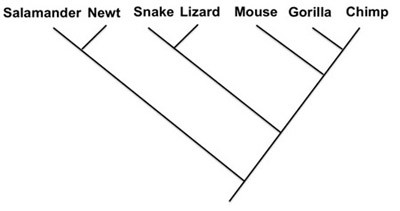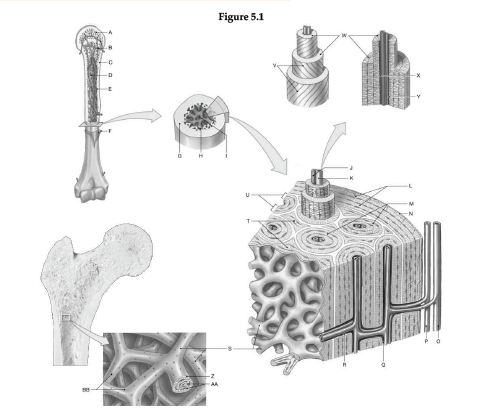 Based on the phylogeny shown, choose the true statements about evolutionary relationships. (Select all that apply.)A) A snake is more closely related to a newt than to a mouse.B) A newt is equally related to a snake and a chimp.C) A mouse is more closely related to a chimp than to a snake.D) A salamander is more closely related to a mouse than to a chimp.
Based on the phylogeny shown, choose the true statements about evolutionary relationships. (Select all that apply.)A) A snake is more closely related to a newt than to a mouse.B) A newt is equally related to a snake and a chimp.C) A mouse is more closely related to a chimp than to a snake.D) A salamander is more closely related to a mouse than to a chimp.
What will be an ideal response?
B, C
Clarify Question
• What is the key concept addressed by the question?
o This question addresses cladistics.
• What type of thinking is required?
o This question is asking you to take what you already know and apply it to this unfamiliar situation.
• What key words does the question contain and what do they mean?
o A phylogeny is a diagram describing a hypothesis about evolutionary relationships.
Gather Content
• What do you already know about cladistics?
o Cladistics is the method used to construct a cladogram-a graphically represented hypothesis of evolutionary relationships.
o Only shared derived characters (synapomorphies) are useful for inferring phylogenies, and they must be contrasted to an outgroup that has the ancestral characters.
o Each nested clade is defined by a new shared derived character. These new characters are typically labeled on the branch.
Consider Possibilities
• Consider the different answer options. Which can you rule out?
o Is a snake more closely related to a newt than to a mouse? No. Snakes are within the same clade as mice.
o Is a salamander more closely related to a mouse than to a chimp? No, because mice and chimps are both members of the same distantly related clade.
Choose Answer
• Given what you now know, what information and/or problem-solving approach is most likely to produce the correct answer?
o Is a newt equally related to a snake and a chimp? Yes, because snakes and chimps are both members of the same clade.
o Is a mouse more closely related to a chimp than to a snake? Yes, because mice and chimps are members of the same clade.
Reflect on Process
• Did your problem-solving process lead you to the correct answer? If not, where did the process break down or lead you astray? How can you revise your approach to produce a more desirable result?
o This question asked you to choose the true statements based on interpreting the phylogeny.
o The question required you to take what you already know and apply it to this unfamiliar situation.
o Did you recognize that looking at the nested clades of a phylogeny can help you to understand how closely related species are?
You might also like to view...
Using the figure below, identify the labeled part.

1) Label A: ______________________________
2) Label B: ______________________________
3) Label C: ______________________________
4) Label D: ______________________________
5) Label E: ______________________________
6) Label F: ______________________________
7) Label G: ______________________________
8) Label H: ______________________________
9) Label I: ______________________________
10) Label J: ______________________________
11) Label K: ______________________________
12) Label L: ______________________________
13) Label M: ______________________________
14) Label N: ______________________________
15) Label O: ______________________________
16) Label P: ______________________________
17) Label Q: ______________________________
18) Label R: ______________________________
19) Label S: ______________________________
20) Label T: ______________________________
21) Label U: ______________________________
22) Label V: ______________________________
23) Label W: ______________________________
24) Label X: ______________________________
25) Label Y: ______________________________
26) Label Z: ______________________________
27) Label AA: ______________________________
28) Label BB: ______________________________
Replica plating
A. is useful for direct selection. B. is useful for identifying auxotrophs. C. uses media on which the mutant will not grow and the parental cell typewill. D. is used to store strains of bacteria. E. is useful for identifying auxotrophs AND uses media on which the mutant will not grow and the parental cell typewill.
Each of the following provides evidence in support of the primary role of RNA in the evolution of life EXCEPT:
A. Some RNA molecules are catalytic. B. ATP (energy currency of the cell) is a ribonucleotide. C. RNA can regulate gene expression. D. RNA is less chemically stable than DNA. E. RNA catalyzes peptide bond formation during protein synthesis.
Explain the structure and functions of the arteries
What will be an ideal response?